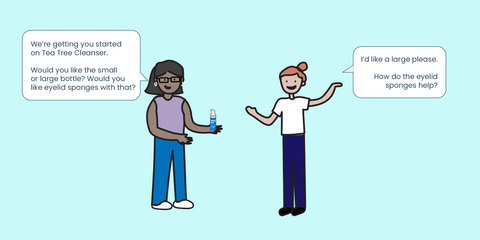Did you know dry eye affects over 50% of your optometry patients? While you prescribe glasses, their eye health journey doesn't end there. Omega-3 vitamins offer scientifically proven benefits, supporting your care and improving patient outcomes.
Frame cross-selling as enhancing patient care, not just sales. Highlight how Omega-3s align with your expertise and address dry eye, a prevalent concern. Emphasize that recommending the right products, like Peeq Pro's, shows you care about their long-term well-being.
Drawing parallels with the iconic "Do you want fries with that?" from McDonald's, optometrists are finding success in recommending accessory products - such as Omega-3 vitamins - to their patients to address dry eye disease and improve overall eye health.
Just like McDonald's seamlessly suggests adding fries to an order, optometrists can incorporate cross selling into their practice. The goal is to recommend additional products that complement the primary service, in this case, eye exams and vision correction. Omega-3 vitamins serve as the perfect "fries order" product, offering benefits beyond traditional eye care. Other examples that could be used include Dry Eye products, such as Peeq Pro’s care kits or Tea Tree Oil cleanser. Some offices have also used warm compresses. The best products have large profit margins but price tags within the budget of most patients.

A key reason that fries are such a good product is that they increase ticket size and profit margin. Based on some online estimates, the profit jumps from ~30% to ~60% when adding a meal deal to a single burger order. Thinking about products in your office (or that could be in your office) to maximize order profit is smart. But, Peeq Pro would emphasize the real goal for optometrists is not necessarily just profit - but to also build good habits in their patients. Getting patients on Omega-3s or an eyelid hygiene regimen is beneficial for the patient beyond good business.
To encourage cross selling and improve patient compliance, optometrists can adopt strategies similar to those used in the fast-food industry. When you walk into a McDonald’s, a customer sees fries and drinks on the walls, prominently displayed, and on the order menu. When you walk into an optometry office, you see glasses and suns. Think about how you can spruce up your office with alternative cross-selling offers. This is particularly useful when coupled with consistent messaging in social media, during check-ins, and in key “waiting” areas.

Here are some compliance examples tailored to cross selling Omega-3 vitamins for dry eye:
- Educational Pamphlets: Provide informative pamphlets in waiting areas explaining the benefits of Omega-3 for eye health. This educates patients and piques their interest before the consultation.
- In-Office Displays: Display Omega-3 supplements prominently in the office, creating a visual reminder for patients. Eye-catching displays can spark conversations during appointments.
- Personalized Recommendations: During consultations, optometrists can assess a patient's specific needs and recommend Omega-3 vitamins accordingly. Tailoring the suggestion enhances the likelihood of acceptance.
- Follow-Up Communication: Implement a follow-up communication strategy to check on patients' progress with Omega-3 supplements. This reinforces the importance of the recommended product and builds trust.
Obviously, these strategies can be used for other products. But, the key to these strategies is to get the patient beyond thinking about the optometry transaction as a “glasses cutting” transaction. Instead, it needs to be considered an eye health journey that includes more than just the office visit.
McDonald's has mastered the art of suggestive selling with their iconic phrase, "Do you want fries with that?" But, they do this by training their employees well. Do your staff and technicians have the same types and level of training to ensure that every checkout includes a key cross sell?
Similarly, optometrists can seamlessly integrate the recommendation of Omega-3 vitamins into the conversation about eye health. The key is to make the suggestion feel natural and genuinely beneficial to the patient because it is. One of our most common challenges from doctors on our products is that the doctor “does not want to be a sales person”. Helping patients find the right product to improve their eye related health is not true selling. You are providing information and data to the patient who has asked you, the expert, to help them. Your products are curated to be the best for your patients - so tell them about the products and why you selected them.
Setting a goal to cross sell Omega-3 vitamins to 25% of clients mirrors the success of fast-food upselling. By incorporating cross selling techniques into optometric practices, professionals can significantly impact patients' eye health while enhancing revenue streams. So, for example, using the data on dry eye - 6-7% of patients have dry eye syndrome (DES) and 50%+ have meibomian gland dysfunction (MGD). If 25% of the MGD group and 50% of the DES audience is cross-sold, your office could be selling 50 additional Omega-3 vitamin bottles per month. That’s a lot of lost revenue AND PATIENT COMPLIANCE.
Cross selling for optometrists, particularly in the context of Omega-3 vitamins for dry eye disease, is a valuable strategy. Just as McDonald's has mastered the art of suggestive selling, optometrists can create a seamless experience for patients by offering products that enhance overall eye health. By adopting innovative cross selling techniques, optometrists can ensure both the well-being of their patients and the success of their practices.

